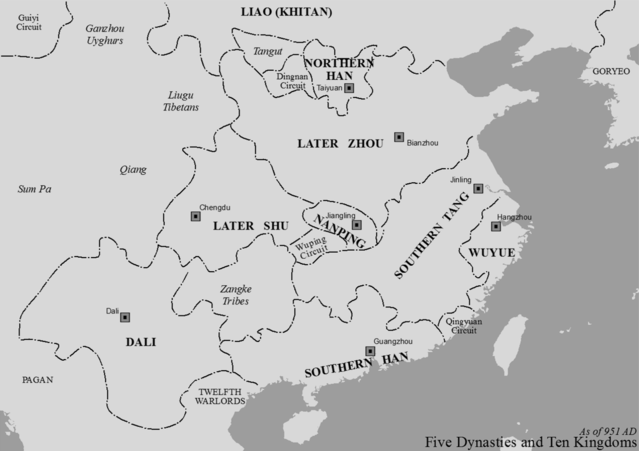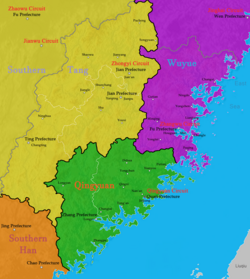Top Qs
Timeline
Chat
Perspective
Qingyuan Prefecture
Minor state in 10th-century China From Wikipedia, the free encyclopedia
Remove ads
Qingyuan Prefecture (Chinese: 清源軍) was a de facto independent prefecture late in China's Five Dynasties and Ten Kingdoms Period, renamed to Pinghai Prefecture (平海軍) in 964. It was an office created in 949 by Southern Tang's second emperor Li Jing for the warlord Liu Congxiao, who nominally submitted to him but virtually controlled Quan Prefecture (泉州, comprising modern Quanzhou, Xiamen and Putian) and Zhang Prefecture (漳州, comprising modern Zhangzhou, Xinluo and Zhangping). Prefectures in de facto independence from the Southern Tang state.[2] (Zhang Prefecture was, at times during the Qingyuan's existence, also known as Nan Prefecture (南州).[3] Starting in 960, in addition to being nominally submissive to Southern Tang, the Qingyuan Prefecture was also nominally submissive to the Song, which had itself become Southern Tang's nominal suzerain.[4]
After demise of Congxiao, the prefecture was briefly ruled by his biological nephew/adoptive son Liu Shaozi, who was then overthrown by the officers Zhang Hansi and Chen Hongjin. Zhang then ruled the prefecture briefly, before Chen deposed him and took over.[3] In 978, with Song's determination to unify China proper without the ceded sixteen prefectures in full order, Chen decided that he could not stay de facto independent and offered the control of the prefecture to Song's Emperor Taizong, ending its existence as a de facto independent entity.[5]


Remove ads
Rulers
- Liu Congxiao 949–962 (in control of Quan Prefecture since 946, de facto independent since 947)
- Liu Shaozi 962
- Zhang Hansi 962–963
- Chen Hongjin 963–978
See also
References
External links
Wikiwand - on
Seamless Wikipedia browsing. On steroids.
Remove ads

